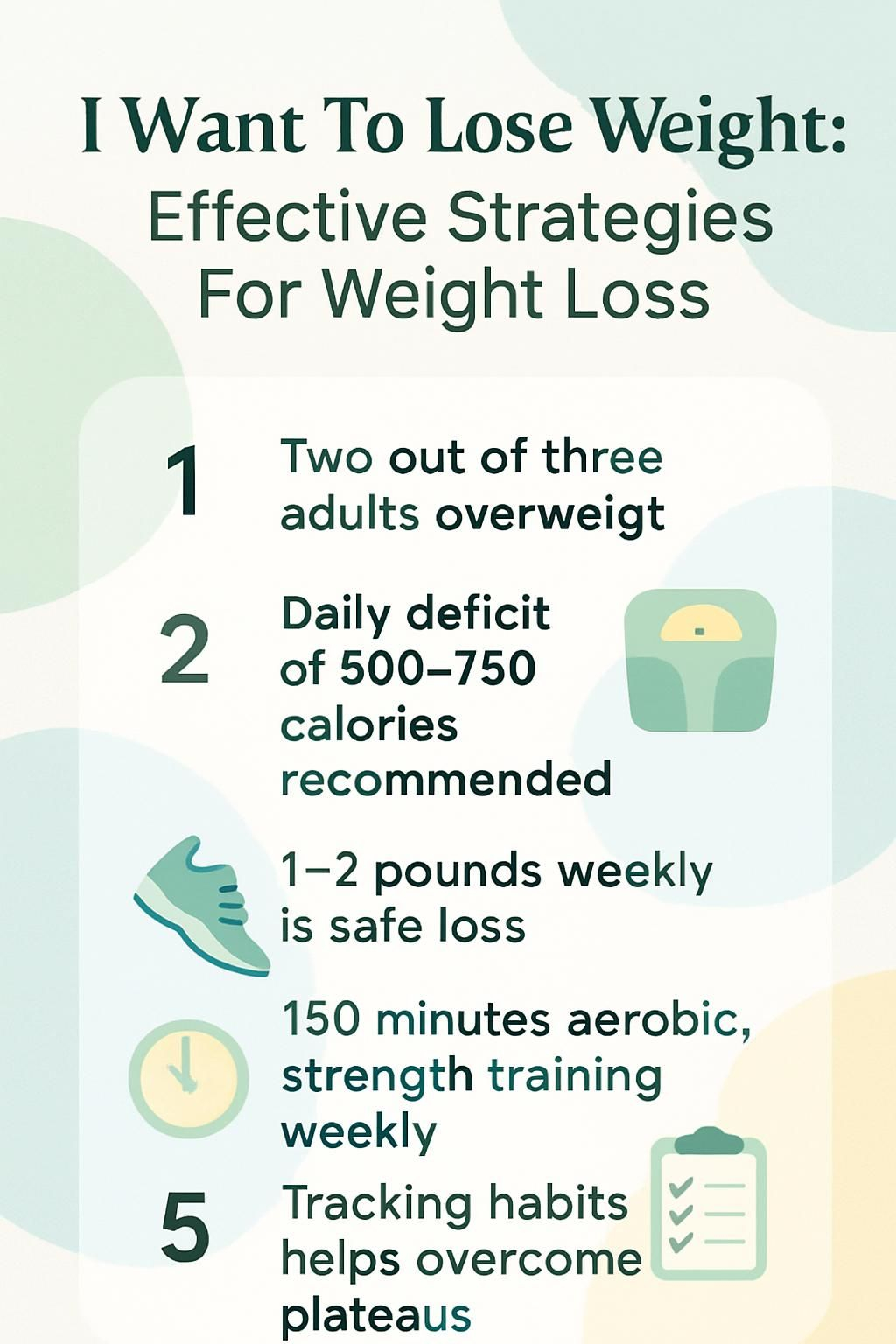I Want To Lose Weight: Effective Strategies For Weight Loss
Our Nutrition Assistant AI Suite will transform your body. You will lose fat, get toned, and build muscle. Gain confidence and optimal health.
If you have ever said, “I want to lose weight,” you are in good company. Nearly two out of three adults in the United States live with excess weight or obesity, which raises the risk of heart disease and type 2 diabetes.
The good news is simple. Lasting changes in daily eating and regular exercise help you reach a healthy weight and keep it. This guide gives you practical steps, like setting realistic goals for weight loss, making healthy choices at home and on the go, and building habits that stick.
Start your journey today and aim for a healthier life with steady progress.
Key Takeaways
- Nearly two out of three U.S. adults have excess weight or obesity, raising the risk for heart disease and type 2 diabetes.
- A daily calorie deficit of 500 to 750 calories can lead to safe weight loss of about 1–2 pounds per week according to the CDC.
- Eating whole foods, increasing fiber from vegetables and grains, and limiting added sugars help reduce calorie intake and support long-term weight management.
- At least 150 minutes of aerobic exercise weekly and twice-weekly strength training are recommended by experts to boost metabolism and preserve muscle during weight loss.
- Tracking food, exercise, sleep, and celebrating small wins helps maintain motivation and overcome common plateaus in a weight loss journey.

Key Concepts of Weight Loss

Think of weight loss as energy in and energy out, guided by smart habits. Understanding calories, metabolism, and consistency helps every safe and successful weight-loss program work better.
What is a calorie deficit and why does it matter?
A calorie deficit means you eat fewer calories than your body uses each day. The Centers for Disease Control and Prevention suggests a daily deficit of 500 to 750 calories for safe progress.
This plan usually leads to losing about 1 to 2 pounds per week, which research shows is effective and manageable for long-term weight management. It also lowers the chance of regaining weight later.
You can create a deficit by eating more vegetables, swapping sugary drinks for water, and checking labels for lower calorie options. I once replaced soda with water and lemon slices, and that single change cut hundreds of calories each week.
One expert says:
“Weight loss requires consuming fewer calories than your body uses.”
Small, steady changes add up over time and help you lose excess weight without feeling deprived.
How does metabolism affect weight loss?
Metabolism is how your body turns food and drinks into energy. It affects how quickly you lose weight. Genes, hormones, age, and medical conditions can influence your metabolic rate.
As you age, metabolism often slows, which can make weight loss harder. Some medicines also change metabolic rate. If you suspect this, speak with your health care provider or a registered dietitian.
Physical activity helps burn calories and supports a higher resting metabolic rate. Strength training builds muscle, and muscle uses more energy than body fat, which increases daily calorie burn.
The American Heart Association recommends at least 150 minutes of aerobic exercise each week to support metabolism and steady weight loss. Many people lose faster at first, then slow down as metabolism adapts to lower body weight.
Why is consistency important for losing weight?
Consistent actions, like balanced meals and regular activity, create a reliable calorie deficit. That steady approach makes results more likely to last.
People who keep off 10 pounds or more often follow routines. Common habits include meal tracking, daily movement, and enough sleep each night. A missed workout or a processed snack here or there will not erase progress if you get back to your plan right away.
Aim for persistence, not perfection. Restart with your next meal or the next day. Consistency turns smart choices into lifelong habits and lowers the risk of regaining lost weight.
Preparing for Your Weight Loss Journey
Preparation builds confidence and gives you a clear plan. Strong goals, personal motivation, and simple tracking tools set the stage for success.
How do I identify my motivation for losing weight?
Begin with a list of reasons you want to lose weight. You may want to improve health, reduce blood pressure, or lower your risk for cardiovascular disease. Some people aim to prevent type 2 diabetes or feel more energetic during physical activities with their kids.
Post reminders where you see them daily to keep motivation strong. Supportive friends and family can help, or you can track privately if you prefer. Losing just 5 percent of your body weight helps health. For a 200-pound adult, that is 10 pounds.
Putting a note on my pantry door about my “why” helped me stick with my healthy choices during stressful weeks.
How can I set realistic and achievable weight loss goals?
Once you know your why, set goals that you can reach and keep. Clear, realistic targets drive steady progress.
- Aim to lose 5 percent of your current weight first. If you weigh 180 pounds, start with a 9-pound target.
- Write short-term goals with deadlines like “Lose 4 pounds in one month,” not vague wishes.
- Work on two or three changes at a time. Too many goals makes consistency harder.
- Use a mix of action goals like “Walk 30 minutes daily” and outcome goals like “Lose 10 pounds.”
- Make goals specific and measurable. “Walk 15 minutes, three days a week” beats “Exercise more.”
- Track your starting point, including body mass index, waist size, and daily habits.
- Expect setbacks. Adjust your strategy instead of quitting after a tough day.
- Ask a health professional before trying very-low-calorie diets, fasting, or meal replacements.
- Celebrate small wins. Positive feedback prevents stress-driven weight cycling.
- Review results often and adjust based on your schedule, taste, and nutrition needs.
Last year I set a goal to walk every morning before school drop-off for two weeks. Focusing on the habit, not just the scale, made success feel possible.
What starting measurements and habits should I track?
Tracking the right numbers shows what is working. Use a food diary, an activity log, or a simple BMI calculator to collect your baseline.
- Weigh yourself weekly using the same scale and conditions. This shows true trends over time.
- Calculate your body mass index with an online BMI calculator. BMI compares weight to height and shows general ranges.
- Log all meals and drinks daily. Include portions, fruit, vegetables, whole grains, lean proteins, and added sugars.
- Track physical activity, from walks to workouts. Note time and intensity since daily movement helps weight loss.
- Keep a sleep journal. Seven to nine hours of sleep supports healthy appetite signals and metabolism.
- Write down stress levels, triggers, and coping tools. High stress can affect hormones that regulate appetite and fat storage.
- Measure waist size with a tape. A smaller waist may appear even when your weight stalls.
- Record how foods affect energy and hunger. This is useful during calorie restriction or intermittent fasting.
- List new habits like meal planning or stocking produce at home. Small wins build momentum and confidence.
I used a free app to track nutrition and noticed cravings after poor sleep or stressful days. That insight led to better meal planning and more consistent workouts over three months.
Dietary Strategies for Weight Loss
Food choices can help you lose the amount of weight you need and keep it off. Use these evidence-based tips to support your weight loss journey.
Why focus on whole, unprocessed foods?
Fresh, unprocessed foods are low in calories and rich in nutrients. That helps you create a calorie deficit without feeling hungry all day.
Whole grains such as brown rice and whole-wheat bread contain more fiber than refined grains. Fiber helps you feel full longer and reduces cravings for processed foods.
Highly processed foods often include added sugars and unhealthy fats that slow progress. A 2020 study in Cell Metabolism found people who ate ultra-processed foods consumed about 500 more calories per day compared to those eating mostly whole foods.
Choosing whole foods supports a healthy eating plan and realistic goals for weight management. Once you build this base, fiber-rich vegetables and grains offer even more help.
How do fiber-rich vegetables and whole grains help weight loss?
Whole, unprocessed foods form the base of a smart eating plan. Fiber-rich vegetables and whole grains add volume to meals while keeping calories reasonable.
Vegetables high in fiber fill your stomach quickly. Experts suggest at least 4 servings of vegetables and 3 servings of fruit each day. Whole grains like brown rice or oatmeal offer complex carbohydrates, which are carbs that digest slowly and give steady energy.
These foods also keep blood sugar steadier, which may reduce cravings for sweets. Clinical nutrition research shows that plant-rich diets often lead to more sustained weight loss than fad diet plans.
In my teens, swapping refined grains for whole grains made meals more satisfying without extra calories. That simple shift cut late-night snacking and made it easier to pass on processed snacks after work.
Fiber Content Table (per serving):
| Food | Fiber (grams) |
|---|---|
| Broccoli, 1 cup | 5 |
| Brown rice, 1 cup | 3 |
| Oatmeal, 1/2 cup dry | 4 |
Fiber supports steady energy for exercise and helps you feel satisfied with smaller portions. A focus on vegetables and whole grains supports digestion and makes weight loss safer and more comfortable under guidance from clinical nutrition teams or bariatric surgery teams if needed.
What are the best lean proteins and healthy fats to eat?
Lean proteins help maintain muscle while you lose weight. Good options include chicken breast, turkey, fish, eggs, beans, tofu, and low-fat or fat-free dairy. The Academy of Nutrition and Dietetics recommends skinless poultry or fish to limit saturated fat.
Greek yogurt, cottage cheese, and skim milk offer protein with fewer calories from fat. Plant proteins like lentils and chickpeas fit well in a plant-based diet and can lower calorie intake.
Healthy fats keep you satisfied and support heart health. Choose olive oil, avocados, nuts, and seeds. Keep portions moderate since nuts and seeds are calorie dense. One ounce of almonds has about 160 calories and healthy unsaturated fat.
Use olive oil on salads or vegetables instead of butter. Watch overall calories from fats to lower the chance of weight regain. These choices support weight loss and reduce risk for chronic diseases like heart disease.
How can I reduce refined carbs and added sugars effectively?
Replace white bread and white rice with whole grain options like brown rice and whole wheat bread. Choose breakfast cereals that are whole grain and low in added sugar. That shift keeps you full longer and steadies morning energy.
Limit desserts and pastries by choosing fresh fruit or unsweetened snacks. Swap sugary drinks for water to remove empty calories fast. One can of soda per day can add more than 150 calories. Tracking meals helps you spot hidden sugars in sauces and packaged foods.
These small swaps reduce calorie intake and support long-term goals for weight loss.
What is mindful eating and how does portion control aid weight loss?
Cutting refined carbs helps control cravings. Paying attention at meals helps too. Mindful eating means focusing on each bite, chewing slowly, and turning off the TV and phone while you eat.
Research from Harvard notes that mindful eating improves hunger awareness. You notice fullness sooner and stop before you feel stuffed. Using smaller plates or measuring tools makes portion sizes easier to manage.
Do not force yourself to clean your plate if you feel satisfied. Save leftovers for later. Skipping meals can lead to overeating, so aim for regular meal times.
Studies in the American Journal of Clinical Nutrition show that people who control portions often eat fewer calories without feeling deprived. Use simple visual guides, like a deck of cards for meat or a cupped hand for grains, to keep portions on track at home or dining out.
Physical Activity for Weight Loss
Exercise burns calories, builds muscle, and often boosts mood, which makes healthy choices easier to keep.
What cardio exercises are effective for weight loss?
Cardio exercises raise your heart rate and help you burn calories. They also reduce stress and support mental health.
- Brisk walking burns fat efficiently. Aim for at least 150 minutes per week, or several 10-minute walks daily.
- Running uses more energy than walking, so it can burn more calories in less time.
- Cycling, indoors or outdoors, is easy on joints and uses large muscles to raise calorie burn.
- Swimming is gentle on joints and works the whole body, a great option for joint pain.
- Tennis engages your body and mind and can burn 400 to 600 calories per hour depending on intensity.
- Group classes like dance aerobics or kickboxing offer social support and strong calorie burn.
- Mix your cardio to prevent boredom and improve consistency, which is key for weight management.
All of these raise daily activity levels, which research links to more successful weight loss efforts.
How does strength training help build muscle and boost metabolism?
Strength training uses resistance, such as weights or your body weight, to build muscle. Muscle tissue burns more calories at rest than fat tissue. More muscle often means a higher resting metabolic rate.
Train at least twice per week. This helps preserve muscle as you lose weight, which supports steady progress. Studies show that combining aerobic exercise with strength training leads to more fat loss and better muscle retention than cardio alone.
Many weight-loss programs recommend a mix of both. My friend added two weekly strength sessions and soon felt more energetic. Clothes fit better, and loss continued without a drop in strength.
How can I increase my daily movement easily?
Small changes in daily movement can create meaningful progress over time. These steps raise calorie burn without a full workout.
- Take stairs instead of elevators. Stair climbing raises heart rate and strengthens leg muscles.
- Park farther away at stores or work to add more steps to your day.
- Stand during phone calls or while reading emails to reduce sitting time.
- Walk during TV commercials or set hourly reminders to move for five minutes.
- Plan activity breaks with coworkers or family so you stay accountable.
- Walk part of your commute if possible. Even ten minutes adds up.
- Bring healthy snacks like fruit or nuts to avoid vending machines.
- Ask HR about workplace wellness programs, step challenges, or fitness classes.
- Use a step tracker and set daily goals like 8,000 to 10,000 steps.
- I started parking farther away in 2022 after my doctor warned my weight may rise without regular movement. Those small steps helped me meet my goals.
Lifestyle Changes for Long-Term Success
Small lifestyle upgrades create big results over time. Healthy living habits help before or after weight-loss surgery, so ask your health care provider for advice that fits your needs.
How much sleep do I need for weight loss?
Aim for 7 to 9 hours of quality sleep each night. Research from the National Sleep Foundation shows that less than seven hours can raise hunger hormones and make healthy choices harder.
Track sleep the same way you track meals and workouts. Patterns in bedtime, wake time, and screen use often explain slow progress.
Set a consistent bedtime and limit screens before bed since blue light lowers melatonin, a sleep hormone. Poor or irregular sleep increases stress, slows metabolism, and encourages overeating.
Adding just one hour of sleep made my plan easier to follow. If sleep still feels out of reach, talk with your health care provider for guidance.
Why is staying hydrated important when losing weight?
Drinking enough water can increase fullness before meals and may support fat burning. Replacing sugary drinks with water also lowers total calories, which helps maintain a calorie deficit.
In a 2016 study, people who drank about 17 ounces, or 500 milliliters, of water before meals ate fewer calories. Regular hydration supports metabolism and steadier energy as you lose weight.
Carrying a refillable bottle pushed me to choose water over soda. That switch reduced added sugar without much effort.
Quick Facts Table:
| Action | Benefit |
|---|---|
| Drink water before meals | Boosts fullness and lowers calorie intake |
| Replace sugary drinks | Cuts daily calories |
| Stay hydrated all day | Supports metabolism and energy |
Hydration works best alongside other proven strategies like portion control and regular exercise.
What are effective stress management techniques?
Stress can disrupt appetite and sleep, which makes weight control harder. Simple habits can bring stress down and make healthy decisions easier.
- Sleep 7 to 9 hours each night. Poor sleep raises cortisol, a stress hormone linked to weight gain, according to 2022 CDC guidance.
- Move your body daily with walking or stretching. Physical activity lowers anxiety by boosting endorphins.
- Practice deep breathing for several minutes each day. It slows the heart rate and calms thoughts.
- Drink enough water, at least 8 cups per day. Good hydration helps appetite control and stress response.
- Track stress tools in a journal or app. Keep the tactics that help you most.
- Seek professional support if stress feels overwhelming or blocks progress.
- Lean on supportive friends, family, or online groups. Social support raises the odds of long-term success.
Setting a fixed bedtime lowered my anxiety during my own weight loss effort last year. Tracking also showed which stress tools worked best for me.
Monitoring Your Progress
Tracking turns guesswork into clear trends. Accurate records help you adjust your plan and stay focused on long-term change in body composition.
How do I track my food intake, activity, and weight?
Good tracking supports better decisions. Food logs, activity records, and weight checks show what helps and what gets in the way.
- Use a food diary to log meals, snacks, and drinks daily. Write down serving sizes and ingredients. Apps like MyFitnessPal can help.
- Keep an activity log with minutes, type, and intensity. Honest records support smart adjustments.
- Weigh yourself at the same time each day or week with a digital scale. Focus on trends, not daily swings.
- Track sleep hours. Aim for 7 to 9 hours per night, which supports weight control and recovery.
- Review weekly patterns with charts or summaries from your app or tracker.
- Set reminders to log after meals or workouts so you do not forget details.
- Protect your privacy with a journal or secure app if you prefer to keep data personal.
- Celebrate wins like more vegetables, higher step counts, or steady sleep.
- Adjust goals if progress stalls. For example, fine-tune calories or increase activity when the scale plateaus.
These steps make it easier to stay accountable and build habits that last.
Why should I celebrate small wins during weight loss?
Small wins add up. Recognizing progress, such as a week of home-cooked meals or hitting a step goal, boosts motivation and reinforces new habits.
Non-food rewards work well. Try fresh flowers, a movie night with friends, or quiet time to relax. Research shows celebrating short-term goals helps people stay consistent over time.
I marked each five-pound loss with an afternoon at the park. That simple reward kept me moving forward.
How can I adjust my plan to overcome weight loss plateaus?
Plateaus happen to almost everyone. Smart adjustments help restart progress and restore confidence.
- Reduce daily calories by 100 to 200. Your body often needs fewer calories as you lose weight.
- Add 10 to 20 minutes of cardio or include another strength session each week.
- Remove hidden calories like sugary drinks or frequent snacks.
- Track food more closely. People often underestimate intake by up to 30 percent.
- Change workout intensity or type to challenge your body again, such as adding HIIT.
- Get 7 to 9 hours of sleep. Poor sleep can slow metabolism and raise hunger hormones.
- Lower stress with breathing, meditation, or hobbies. High cortisol encourages belly fat storage.
- Celebrate small wins to keep morale high during tougher stretches.
- Review goals and refine them based on the latest results.
Finding support from friends or a community can make changes easier and less isolating.
Finding Support
Support creates accountability and keeps motivation strong. A good network makes healthy choices easier to maintain.
How can joining a weight-loss group or online community help?
Groups and online communities offer accountability, ideas, and encouragement. Many people find it easier to stay on track with regular check-ins.
- You gain accountability through check-ins and weigh-ins.
- People facing similar challenges can share strategies that work in daily life.
- Community programs may include classes, expert advice, and social events.
- Public progress tracking can raise commitment for some members.
- Scheduled follow-ups and health checks help you stay on course.
- Sharing stories teaches practical tips and builds confidence.
- Supportive friends or family in the group celebrate milestones with you.
- Being part of a caring network can lift your mood after setbacks and refocus you on progress.
When should I work with a dietitian or personal trainer?
A registered dietitian can tailor a plan to your needs, tastes, and medical conditions. If you manage diabetes, high blood pressure, or take medicines that affect metabolism, professional guidance is a smart step.
Dietitians offer expert advice on healthy eating patterns and safe calorie deficits. A personal trainer helps improve fitness safely, teaches proper form, and helps you break exercise plateaus.
After my weight loss stalled, my trainer changed my plan and progress resumed within weeks. Professional support often boosts motivation and builds lasting habits.
Friends and family can also help. Their support keeps you accountable between appointments.
How do supportive friends and family impact my weight loss journey?
Encouragement from loved ones raises your chances of success. Studies show people with social support are more likely to achieve and maintain weight loss goals.
Share your goals and challenges with someone you trust. Invite family to help with healthy meal planning or join you for daily walks. A simple weekly check-in from a friend can keep you moving.
Involving family in nutrition changes reduces the pull of old habits. Research published in 2022 found that people who involved friends or relatives lost more weight over six months compared to those who went alone.* Set yourself up for success by making support part of your plan.
…
*Source: Journal of Obesity, 2022
Debunking Weight Loss Myths
Myths create confusion and slow progress. Knowing the facts helps you make better choices.
What’s wrong with fad diets compared to sustainable lifestyles?
Fad diets promise fast results, but they rarely last. Research from the National Institutes of Health shows most people on extreme or trendy diets regain the lost weight within one to five years.
These plans may cut calories too far or remove entire food groups. This can cause fatigue, nutrient gaps, and other health problems. Some popular trends even raise safety concerns because vitamins and minerals may be too low.
Sustainable changes build healthy habits around eating and activity. That method supports long-term weight management and overall health. Safe weight-loss programs recommend gradual progress and flexibility with food choices.
I tried a juice cleanse once and lost a few pounds in a week. Hunger and low energy made it impossible to continue. Small daily changes helped me lose weight and keep it off without feeling unwell.
Why doesn’t spot-reduction work for losing fat?
Spot-reduction claims you can burn fat in one area by training it, but there is no proof. Doing endless crunches will not melt belly fat.
Fat loss happens across the whole body when you maintain a calorie deficit and stay active. Studies confirm that targeted exercises do not reduce fat in isolated spots.
I hoped extra leg exercises would shrink my thighs faster. That did not happen, even with consistent workouts and calorie tracking. Focus on whole-body fitness, balanced eating, and a calorie deficit for real fat loss.
What is the truth about rapid weight loss?
Rapid weight loss can show quick results, but it usually does not last. Most experts suggest aiming for 1 to 2 pounds per week for better long-term success.
Very strict diets can lead to nutrient shortages and health risks. Fast loss also often includes water and muscle, not just fat. Many people regain lost pounds once they return to normal eating.
When I lost weight too quickly, I felt exhausted. Steady progress helped me build healthier routines and keep the results.
Summary Table:
| Approach | Typical Weekly Loss | Long-Term Success Rate |
|---|---|---|
| Rapid Weight Loss | > 2 lbs | Low |
| Steady Weight Loss | 1–2 lbs | Higher |
Extreme approaches rarely lead to lasting results. Small, steady steps make the biggest difference.
Maintaining Weight Loss Over Time
Keeping weight off takes continued effort. The right habits protect your progress and support a healthy lifestyle.
How do I transition to a maintenance plan?
After reaching your goal, shift to a maintenance plan to protect progress. An organized plan helps prevent regain.
- Increase daily calories slowly, about 100–200 calories per week, to avoid rapid weight gain.
- Keep tracking food with a diary or app to stay aware of changes.
- Maintain regular exercise three to five times per week, including cardio and strength training.
- Weigh yourself weekly and record the numbers to spot trends early.
- Set new short-term and long-term goals so focus stays on healthy living.
- Review your plan monthly and adjust exercise or meals as your needs change.
- Ask friends, family, or a dietitian for accountability during the transition.
These habits make it easier to keep the weight off and feel confident with your routine.
What healthy habits support long-term weight maintenance?
Healthy routines make maintenance more stable. Simple actions keep your body and mind on track.
- Choose mostly whole foods like fruits, vegetables, and whole grains for fiber and steady energy.
- Prioritize lean proteins such as chicken breast, fish, beans, or tofu to help maintain muscle.
- Practice mindful eating and use portion control to prevent overeating.
- Get at least 150 minutes of cardio activity each week per CDC guidelines.
- Do strength training two or three times weekly. Muscle burns more calories at rest than fat.
- Sleep 7 to 9 hours nightly to reduce cravings and lower the risk of regain.
- Drink water regularly. Thirst is often mistaken for hunger.
- Track your habits in an app or journal to spot shifts early.
- Manage stress with hobbies, music, or conversations with friends to limit emotional eating.
When I lost 35 pounds in college, consistent tracking and supportive friends made lasting change much easier.
How can I prevent regaining lost weight?
Check your progress weekly and adjust quickly if weight creeps up. Keep healthy snacks like fruit, popcorn, or rice cakes at home instead of stocking ultra-processed treats.
Lean on support from friends, family, or online communities. Continue regular meals, mindful eating, and steady activity. People who maintain weight loss usually keep a close eye on habits and seek help when needed.
Research shows that weekly weighing and consistent behaviors help prevent weight regain over time.
Conclusion
Successful weight loss comes from clear motivation, realistic goals, and steady effort. Focus on whole foods like vegetables, fruits, lean proteins, and healthy fats to support your plan. Regular physical activity helps burn calories and improves mood and sleep.
Choose patience over quick fixes. Celebrate small wins to stay motivated during tough weeks. With consistent habits and daily choices, you can reach a healthy weight and keep it for the long term. For personal medical advice, speak with your health care provider or a registered dietitian.
FAQs
1. What are the most effective strategies for weight loss?
Effective strategies include eating fewer calories, increasing physical activity, and choosing nutrient-rich foods. Studies show that people who track their food intake and exercise lose more weight than those who do not (National Institutes of Health). Setting realistic goals and making gradual changes help maintain long-term results.
2. How does regular exercise support weight loss?
Regular movement burns calories and helps keep muscle while losing fat. The Centers for Disease Control and Prevention recommend at least 150 minutes of moderate-intensity aerobic activity each week for adults. Combining strength training with cardio improves body composition.
3. Can changing what I eat lead to lasting weight loss?
Yes; focusing on whole grains, lean proteins like chicken or fish, fruits, vegetables, and healthy fats supports steady progress. Reducing added sugars and processed foods lowers calorie intake without sacrificing nutrition (Harvard School of Public Health).
4. Is there scientific evidence supporting these methods?
Research from trusted sources such as the Mayo Clinic confirms that a balanced diet paired with consistent physical activity leads to safe weight reduction over time. Personal experience shows that tracking meals helped me notice patterns in my eating habits; this made it easier to make healthier choices daily.
Summary:
Weight management relies on proven steps: reduce calories, move more often, choose nutritious foods, set clear goals, monitor habits, and use credible research as guidance throughout your journey toward better health.







